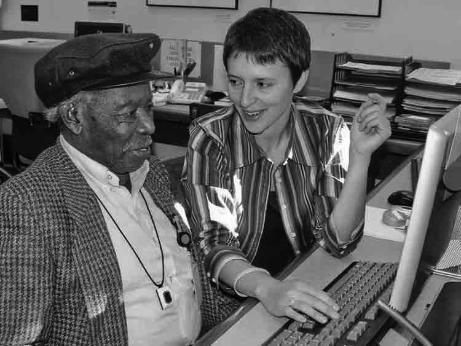CAPTION: Hennepin County Library offers computer classes at Minneapolis and to address the digital divide.

In 2012, the City of Minneapolis conducted a community technology survey that revealed significant disparities among residents’ access to computers and the Internet, as well as a knowledge gap for using these tools. North Minneapolis, the survey showed, was among the areas in which communications technology access and usage were lowest.
This past month the city’s Information Technology Department replicated the survey, increasing the sample size, to explore how the digital divide has changed over the course of a year. Sent to roughly 12,400 households throughout the city, the survey is intended to capture data on residents’ current access to, use of, and comfortableness with computers, mobile devices, and the Internet. Survey results will inform city initiatives for bridging the digital divide, the gap in accessibility and use of communications technology that exists among some population groups.
Findings from the latest survey, expected in March, are eagerly awaited by digital inclusion advocates and community leaders, particularly in areas like North Minneapolis where some of the greatest technology disparities have been observed. For example, last year’s survey showed that while 82 percent of households citywide have a computer with Internet access, only 65 percent of Near North community households have a computer online. The number of Camden households with an Internet-connected computer is higher at 78 percent, but still below the city average.
The scope of the community technology survey, which consists of 10 questions, extends beyond equipment ownership and Internet connectivity. The survey also examines usage habits and residents’ perspectives on the role of technology in their lives. Individuals have been asked to supply responses to questions about how often they use the Internet for specific activities like social networking, which electronic devices they use to go online, and what home connection services they utilize. Additionally, the survey asks for information on how comfortable respondents are using email, searching for employment, running computer applications and performing other tasks online.
In an example of the type of information public officials are looking for, last year’s report revealed that “too many residents do not feel very comfortable finding and applying for jobs online” and that they are also “not comfortable attaining education online.” Officials see these and other personal and professional development activities as being increasingly important toward the long-term success of Minneapolis residents—and the city itself. The Information Technology Department’s vision affirms that “the city becomes stronger the more its residents take advantage of computing and the vast sea of knowledge the Internet offers, to achieve their educational, economic, civic and social goals.”
Elise Ebhardt, project coordinator at the department, provided insight on the intended benefits of the survey. “The survey results will be presented to the community to use in a variety of ways, and to help us prioritize the city’s digital inclusion focus areas for 2013,” Ebhardt said. “Educators and computer training providers can use the data to target training, plan programming and curriculum, and more strategically match resources and location-based services in the highest need areas. Neighborhood groups can help connect residents to their nearest community technology center and help providers learn new ways to meet community needs.”
Residents, randomly selected for the survey, were strongly encouraged to participate given that findings are likely to influence community outreach and education programming initiatives, including in the Camden and Near North communities where greater digital access is a pressing need. Citywide, the report of the survey’s findings is likely to be influential in public policy discussions on such important issues as longstanding deficits in computer and Internet access among some racial/ethnic groups. Last year’s survey, for example, revealed that only 52 percent of respondents identifying as Black or African American reported being in households with an Internet-connected computer—30 percent below the city average.
A series of community meetings will be announced when the survey report is released in March. City officials hope to engage residents, neighborhood leaders and digital inclusion advocates in discussions about how to best address the digital divide in Minneapolis. Interested individuals can monitor the Digital Inclusion webpage of the city’s Information Technology Department (www.minneapolismn. gov/it/inclusion). The website features more info on the survey, updates on technology equality initiatives, outreach materials, and additional resources.